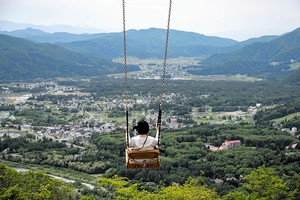THE ASAHI SHIMBUN
April 2, 2024 at 15:23 JST
Japan plans to upgrade five civilian airports and 11 seaports for use by the Self-Defense Forces and the Japan Coast Guard to bolster the nation’s defense capabilities.
The 16 facilities in seven prefectures were designated as “specified use airports and seaports” on April 1.
The central government has obtained consent for the upgrades from the local governments concerned.
For the current fiscal year, 37 billion yen ($244 million) was earmarked to extend runways and improve berths to accommodate SDF and JCG aircraft and vessels.
In ordinary times, the SDF and JCG are expected to use the facilities for training, transportation of goods, evacuation of people and disaster responses.
The five airports are: Kita-Kyushu; Nagasaki and Fukue in Nagasaki Prefecture; Miyazaki; and Naha.
The 11 seaports are: Muroran, Tomakomai, Kushiro, Rumoi and Ishikari-wan Shinko in Hokkaido; Takamatsu; Kochi, Susaki and Sukumo-wan in Kochi Prefecture; Hakata in Fukuoka Prefecture; and Ishigaki in Okinawa Prefecture.
The plan to “develop public infrastructure facilities,” such as airports and seaports, to strengthen defense was spelled out in the National Security Strategy of Japan, which was established in 2022.
Thirty-eight airports and seaports were on the list of candidate sites last autumn, and the government has held discussions with local governments over the designations.
However, some local governments were concerned that designated facilities may become targets for military attacks in emergencies, officials said.
The government said it plans to continue discussions with the remaining local governments to designate more facilities.
The government prioritized facilities in the southwestern Nansei Islands, including Okinawa Prefecture, due to growing concerns over a military conflict in the nearby Taiwan Strait.
Ishigaki Mayor Yoshitaka Nakayama welcomed the designation of Ishigaki Port in Okinawa Prefecture.
“It will enhance deterrence and lead to rapid responses to disasters,” he told a news conference on April 1.
While Naha Airport, administered by the central government, was designated, New Ishigaki Airport and Yonaguni Airport, also in Okinawa Prefecture and both on the government’s candidate list, were not.
The latter two are administered by the prefectural government.
“The main worry is an airport being jointly used by Japan and the United States,” a senior prefectural official said April 1. “We should warn against thoughtless operations.”
No facility was designated in Kagoshima Prefecture, where two airports and six seaports were up for discussions with the central government.
“We were not ready to make a decision because we had not received a full explanation from the government,” a prefectural official said.
At a news conference on April 1, Kagawa Governor Toyohito Ikeda emphasized that Takamatsu Port will continue to be used primarily for civilian use even after the designation.
Akihiro Sado, a professor at Chukyo University and a national security expert, said the government is unilaterally proceeding with the project based solely on military necessity, without any explanation to local governments and residents.
“Little consideration has been given to how to protect the people and evacuate them in the event of an emergency,” he said.




















A peek through the music industry’s curtain at the producers who harnessed social media to help their idols go global.
A series based on diplomatic documents declassified by Japan’s Foreign Ministry
Here is a collection of first-hand accounts by “hibakusha” atomic bomb survivors.
Cooking experts, chefs and others involved in the field of food introduce their special recipes intertwined with their paths in life.
A series about Japanese-Americans and their memories of World War II